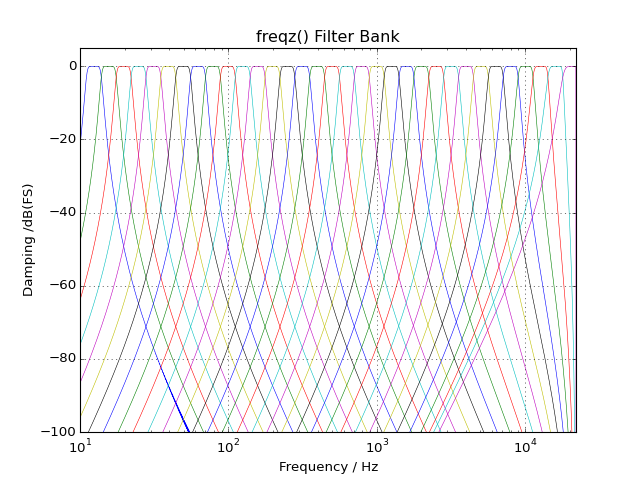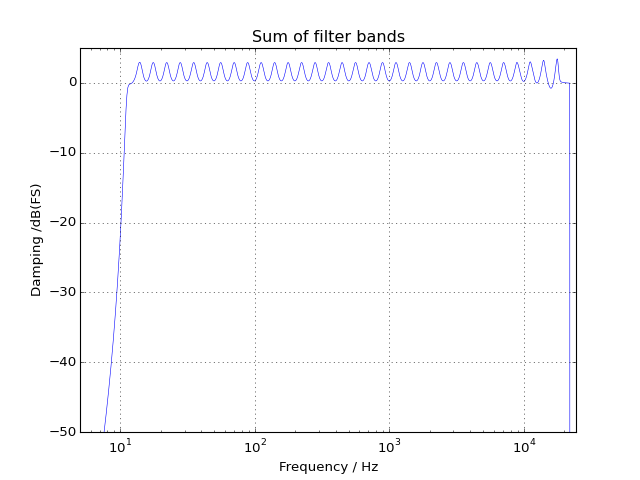Fractional Octave Filter Bank¶
Module name: octbank
This module implements a fractional octave filter bank.
The band passes are realized with butterworth second order sections
described by [Stearns2002].
For the second order section filter routines the
module sosfiltering is used.
With the class FractionalOctaveFilterbank you can create
filtering objects that apply to the [IEC-61260].
An example filter bank is shown by the figures below.
References¶
| [Stearns2002] | Stearns, Samuel D., Digital Signal Processing with examples in MATLAB |
| [IEC-61260] | Electroacoustics - Octave-band and fractional-octave-band filters |
Functions¶
-
class
pyfilterbank.octbank.FractionalOctaveFilterbank(sample_rate=44100, order=4, nth_oct=3.0, norm_freq=1000.0, start_band=-19, end_band=13, edge_correction_percent=0.01, filterfun='cffi')[source]¶ Fractional octave filter bank with second order section butterworth band passes.
Parameters: sample_rate : int
Sampling rate of the signals to be filtered.
order : int
Filter order of the bands. As this are second order sections, it has to be even. Otherweise you’ll get an error.
nth_oct : scalar
Number of bands per octave.
norm_freq : scalar
This is the reference frequency for all fractional octaves placed around this band.
start_band : int
First Band number of fractional octaves below norm_freq.
end_band : int
Last band number of fractional octaves above norm_freq.
edge_correction_percent : scalar
Percentage of widening or narrowing the bands.
filterfun : {‘cffi’, ‘py’, ‘cprototype’}
Function used by the method
filter().Examples
>>> from pyfilterbank import FractionalOctaveFilterbank >>> from pylab import plt, np >>> >>> sample_rate = 44100 >>> ofb = FractionalOctaveFilterbank(sample_rate, order=4) >>> >>> x = np.random.randn(4*sample_rate) >>> y, states = ofb.filter(x) >>> L = 10 * np.log10(np.sum(y*y,axis=0)) >>> plt.plot(L)
Attributes
center_frequencies (ndarray) band_edges (ndarray) Frequencies at -3 dB point for all band passes. This are the cross sections of the bands if no edge correction applied. sosmat (ndarray) Filter coefficient matrix with second order section band passes. num_bands (int) Number of frequency bands in the filter bank. band_widths (ndarray) The -3 dB band width of each band pass in the filter bank. Methods
-
effective_filter_lengths¶ Returns an estimate of the effective filter length
-
filter(x, ffilt=False, states=None)[source]¶ Filters the input by the settings of the filterbank object.
Parameters: x : ndarray
Input signal (Nx0)
ffilt : bool
Forward and backward filtering, if Ture.
states : dict
States of all filter sections in the filterbank. Initial you can states=None before block process.
Returns: y : ndarray
Fractional octave signals of the filtered input x
states : dict
Dictionary containing all filter section states.
-
filter_mimo_c(x, states=None)[source]¶ Filters the input by the settings of the filterbank object.
It supports multi channel audio and returns a 3-dim ndarray. Only for real valued signals. No ffilt (backward forward filtering) implemented in this method.
Parameters: x : ndarray
Signal to be filtered.
states : ndarray or None
States of the filter sections (for block processing).
Returns: signal : ndarray
Signal array (NxBxC), with N samples, B frequency bands and C-signal channels.
states : ndarray
Filter states of all filter sections.
-
-
class
pyfilterbank.octbank.ThirdOctFFTLevel(fmin=30, fmax=17000, nfft=16384, fs=44100, flag_mean=False)[source]¶ Third octave levels by fft. TODO: rename variables TODO: Write Documentation
Methods
-
pyfilterbank.octbank.centerfreq_to_bandnum(center_freq, norm_freq, nth_oct)[source]¶ Returns band number from given center frequency.
-
pyfilterbank.octbank.design_sosmat_band_passes(order, band_edges, sample_rate, edge_correction_percent=0.0)[source]¶ Return matrix containig sos coeffs of bandpasses.
Parameters: order : int
Order of the band pass filters.
band_edges : ndarray
Band edge frequencies for the bandpasses.
sample_rate : scalar
Sample frequency.
edge_correction_percent : scalar
Percentage for the correction of the bandedges. Float between -100 % and 100 %. It can be helpfull dependent on the used filter order. p > 0 widens the band passes.
Returns: sosmat : ndarray
Second order section coefficients. Each column is one band pass cascade of coefficients.
-
pyfilterbank.octbank.design_sosmat_low_pass_high_pass_bounds(order, band_edges, sample_rate)[source]¶ Returns matrix containing sos coeffs of low and highpass. The cutoff frequencies are placed at the first and last band edge.
Note
This funtion is not used anymore.
Parameters: order : int
Order of the band pass filters.
band_edges : ndarray
Band edge frequencies for the low an highpass.
sample_rate : scalar
Sample rate.
Returns: sosdict : ndarray
Second order section coefficients, the first column contains the low pass coefs and the second column contains the highpass coeffs.
-
pyfilterbank.octbank.example_plot()[source]¶ Creates a plot with
freqz()of the defaultFractionalOctaveFilterbank.
-
pyfilterbank.octbank.find_nominal_freq(center_frequencies, nominal_frequencies)[source]¶ Find the nearest nominal frequencies to a given array.
Parameters: center_frequencies : ndarray
Some frequencies for those the neares neighbours shall be found.
nominal_frequencies : ndarray
The nominal frequencies we want to get the best fitting values to center_frequencies from.
Returns: nominal_frequencies : generator object
The neares neighbors nomina freqs to the given frequencies.
-
pyfilterbank.octbank.frequencies_fractional_octaves(start_band, end_band, norm_freq, nth_oct)[source]¶ Return center and band edge frequencies of fractional octaves.
Parameters: start_band : int
The starting center frequency at norm_freq`*2^(`start_band/nth_oct).
end_band : int
The last center frequency at norm_freq`*2^(`end_band/nth_oct).
norm_freq : scalar
The center frequency of the band number 0.
nth_oct : scalar
The distance between the center frequencies. For third octaves nth_oct=3.
Returns: center_frequencies : ndarray
Frequencies spaced in nth_oct from start_band to end_band with the norm_freq at band number 0.
band_edges : ndarray
Edge frequencies (-3 dB points) of the fractional octave bands. With constant relative Bandwidth.
-
pyfilterbank.octbank.freqz(ofb, length_sec=6, ffilt=False, plot=True)[source]¶ Computes the IR and FRF of a digital filter.
Parameters: ofb : FractionalOctaveFilterbank object
length_sec : scalar
Length of the impulse response test signal.
ffilt : bool
Backard forward filtering. Effectiv order is doubled then.
plot : bool
Create Plots or not.
Returns: x : ndarray
Impulse test signal.
y : ndarray
Impules responses signal of the filters.
f : ndarray
Frequency vector for the FRF.
Y : Frequency response (FRF) of the summed filters.
-
pyfilterbank.octbank.to_normalized_frequencies(frequencies, sample_rate, clip=True)[source]¶ Returns normalized frequency array.
Parameters: frequencies : ndarray
Vector with given frequencies.
sample_rate : scalar
The sample rate. Frequencies beyond Nyquist criterion will be truncated.
Returns: normalized_frequencies : ndarray
Normalized, truncated frequency array.

